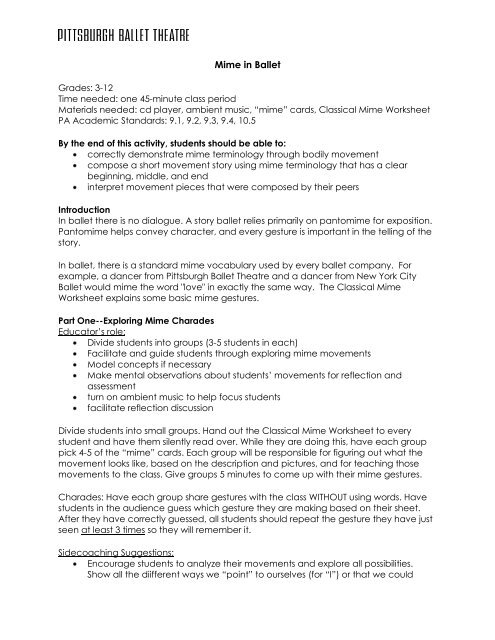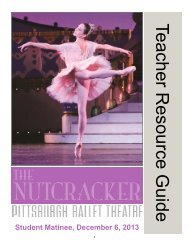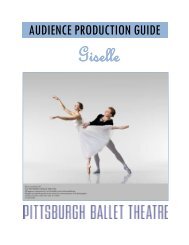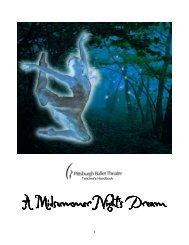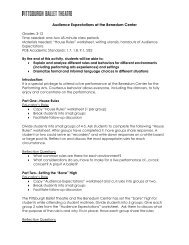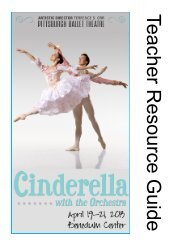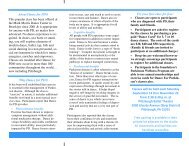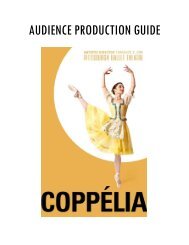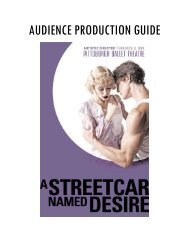Mime in Ballet - Pittsburgh Ballet Theatre
Mime in Ballet - Pittsburgh Ballet Theatre
Mime in Ballet - Pittsburgh Ballet Theatre
You also want an ePaper? Increase the reach of your titles
YUMPU automatically turns print PDFs into web optimized ePapers that Google loves.
<strong>Mime</strong> <strong>in</strong> <strong>Ballet</strong><br />
Grades: 3-12<br />
Time needed: one 45-m<strong>in</strong>ute class period<br />
Materials needed: cd player, ambient music, “mime” cards, Classical <strong>Mime</strong> Worksheet<br />
PA Academic Standards: 9.1, 9.2, 9.3, 9.4, 10.5<br />
By the end of this activity, students should be able to:<br />
correctly demonstrate mime term<strong>in</strong>ology through bodily movement<br />
compose a short movement story us<strong>in</strong>g mime term<strong>in</strong>ology that has a clear<br />
beg<strong>in</strong>n<strong>in</strong>g, middle, and end<br />
<strong>in</strong>terpret movement pieces that were composed by their peers<br />
Introduction<br />
In ballet there is no dialogue. A story ballet relies primarily on pantomime for exposition.<br />
Pantomime helps convey character, and every gesture is important <strong>in</strong> the tell<strong>in</strong>g of the<br />
story.<br />
In ballet, there is a standard mime vocabulary used by every ballet company. For<br />
example, a dancer from <strong>Pittsburgh</strong> <strong>Ballet</strong> <strong>Theatre</strong> and a dancer from New York City<br />
<strong>Ballet</strong> would mime the word "love" <strong>in</strong> exactly the same way. The Classical <strong>Mime</strong><br />
Worksheet expla<strong>in</strong>s some basic mime gestures.<br />
Part One--Explor<strong>in</strong>g <strong>Mime</strong> Charades<br />
Educator’s role:<br />
Divide students <strong>in</strong>to groups (3-5 students <strong>in</strong> each)<br />
Facilitate and guide students through explor<strong>in</strong>g mime movements<br />
Model concepts if necessary<br />
Make mental observations about students’ movements for reflection and<br />
assessment<br />
turn on ambient music to help focus students<br />
facilitate reflection discussion<br />
Divide students <strong>in</strong>to small groups. Hand out the Classical <strong>Mime</strong> Worksheet to every<br />
student and have them silently read over. While they are do<strong>in</strong>g this, have each group<br />
pick 4-5 of the “mime” cards. Each group will be responsible for figur<strong>in</strong>g out what the<br />
movement looks like, based on the description and pictures, and for teach<strong>in</strong>g those<br />
movements to the class. Give groups 5 m<strong>in</strong>utes to come up with their mime gestures.<br />
Charades: Have each group share gestures with the class WITHOUT us<strong>in</strong>g words. Have<br />
students <strong>in</strong> the audience guess which gesture they are mak<strong>in</strong>g based on their sheet.<br />
After they have correctly guessed, all students should repeat the gesture they have just<br />
seen at least 3 times so they will remember it.<br />
Sidecoach<strong>in</strong>g Suggestions:<br />
Encourage students to analyze their movements and explore all possibilities.<br />
Show all the diifferent ways we “po<strong>in</strong>t” to ourselves (for “I”) or that we could
“hold up two f<strong>in</strong>gers high” (for “true/faithful”). What seems to represent the idea<br />
the clearest?<br />
Rehearse how you are go<strong>in</strong>g to teach the movement to the class as a group<br />
without talk<strong>in</strong>g. What will you teach first, second, third, and fourth?<br />
What could the rest of your body be<strong>in</strong>g do<strong>in</strong>g dur<strong>in</strong>g these mimes--legs, arms,<br />
face? Show us what the idea is with these other body parts (especially the<br />
face!).<br />
Reflection Questions for Part One--Explor<strong>in</strong>g <strong>Mime</strong> Charades<br />
What were all the different ways you communicated with your group dur<strong>in</strong>g this<br />
activity? How did you have to change your communication when you weren’t<br />
allowed to talk?<br />
Quick check: Without look<strong>in</strong>g at the worksheet, recall 3 of the most <strong>in</strong>terest<strong>in</strong>g<br />
mime gestures you saw or did and expla<strong>in</strong> why they were <strong>in</strong>terest<strong>in</strong>g.<br />
Part Two--Create your own mime story!<br />
Educator’s role:<br />
Divide students <strong>in</strong>to groups (3-5 students <strong>in</strong> each)<br />
Facilitate and guide students through creat<strong>in</strong>g their own mime stories<br />
Model concepts if necessary<br />
Make mental observations about students’ movements for reflection and<br />
assessment<br />
turn on ambient music to help focus students<br />
facilitate reflection discussion<br />
In small groups, students will create a story us<strong>in</strong>g just mime movements us<strong>in</strong>g one of the<br />
variations below. Allow students 5-10 m<strong>in</strong>utes to create a story us<strong>in</strong>g the 6 movements.<br />
The 6 movements should be connected by other movement of “characters” go<strong>in</strong>g on<br />
or off stage, made up mime gestures, transitions, etc. The story should have a clear<br />
beg<strong>in</strong>n<strong>in</strong>g, middle, and end. After the students have completed their short movement<br />
stories, share with the class.<br />
Variation 1: Each group should choose 6 movements from the Classical <strong>Mime</strong><br />
Worksheet to create a story.<br />
Variation 2: Students draw 6 “mime cards” (will need an extra set) and create a mime<br />
story us<strong>in</strong>g these.<br />
Sidecoach<strong>in</strong>g Suggestions:<br />
Have a strong beg<strong>in</strong>n<strong>in</strong>g, middle, and end. How could you start and end the<br />
piece?<br />
If you are stuck, draft out your story on paper first to understand how to connect<br />
all the gestures.<br />
Rehearse, rehearse, rehearse!<br />
What could the rest of your body be<strong>in</strong>g do<strong>in</strong>g dur<strong>in</strong>g these mimes--legs, arms,<br />
face? Show us what the idea is with these other body parts (especially the<br />
face!).
Reflection Questions for Part Two—Create your own mime story!<br />
What was your <strong>in</strong>terpretation of this group’s story? Does anyone have a different<br />
<strong>in</strong>terpretation?<br />
How did different groups effectively communicate their story? What did they do<br />
with their bodies?<br />
Why is it important to speak with our bodies as well as our words?<br />
Assessment<br />
Observation of participation and engagement dur<strong>in</strong>g movement activities.<br />
Participation and <strong>in</strong>sights dur<strong>in</strong>g reflection.<br />
Interpretation of <strong>Pittsburgh</strong> <strong>Ballet</strong> <strong>Theatre</strong> performance—did the concepts<br />
transfer?
Classical <strong>Mime</strong> Worksheet<br />
Here are common ideas <strong>in</strong> mime and the physical movement used to express<br />
these ideas.<br />
Ideas<br />
I<br />
K<strong>in</strong>g<br />
Devil<br />
Love<br />
Knock<strong>in</strong>g<br />
Sew<strong>in</strong>g<br />
You/He/She<br />
Th<strong>in</strong>k<br />
See<br />
Beautiful/Handsome<br />
Crazy<br />
Marry<br />
True/Faithful<br />
Dress<br />
Hear<br />
Someone<br />
Enter<br />
Cry<br />
Mice/Rats<br />
Dance<br />
Die/dead<br />
Yes<br />
No<br />
Movement<br />
po<strong>in</strong>t to yourself<br />
hand gestures on sides of head <strong>in</strong> form of crown<br />
two gestures on top of head/f<strong>in</strong>gers <strong>in</strong> shape of horns<br />
two hands on heart<br />
tap fist <strong>in</strong> hand three times<br />
pull needle through fabric<br />
gesture to other person palm up<br />
touch your temple<br />
po<strong>in</strong>t to each eye<br />
circle your face/draw hand down face<br />
circle around your ear<br />
po<strong>in</strong>t to your r<strong>in</strong>g f<strong>in</strong>ger<br />
hold two f<strong>in</strong>gers high<br />
gesture along sides of cloth<strong>in</strong>g<br />
cup your ear with your hand<br />
hold your first f<strong>in</strong>ger up<br />
sweep<strong>in</strong>g gesture with both arms across your body<br />
gesture with all f<strong>in</strong>gers from eyes<br />
mov<strong>in</strong>g f<strong>in</strong>gers as whiskers<br />
circl<strong>in</strong>g hands overhead<br />
cross arms-hands <strong>in</strong> fist<br />
nod head<br />
turn head or gesture with arms
<strong>Mime</strong> Cards<br />
I<br />
K<strong>in</strong>g<br />
Devil<br />
Love<br />
Knock<strong>in</strong>g<br />
Sew<strong>in</strong>g<br />
You/He/She<br />
Th<strong>in</strong>k<br />
See<br />
Beautiful/Handsome<br />
Crazy<br />
Marry<br />
True/Faithful<br />
Dress<br />
Hear<br />
Someone<br />
Enter<br />
Cry
Mice/Rats<br />
Dance<br />
Die/Dead<br />
Yes<br />
No


